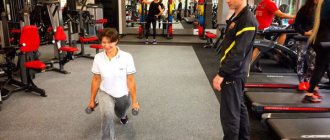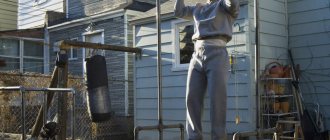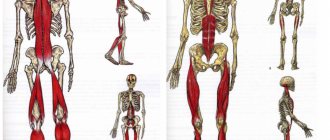Split training (English split - to split, split) is a method of constructing sports activities, which involves dividing the training program into parts and performing them on different days. This principle is used in bodybuilding and helps the athlete to load the necessary muscles well in a short period of time.
Advantages of the technique:
- Accented elaboration . Each lesson is aimed at developing a selected muscle group, which allows you to gradually increase weight loads.
- Optimal rest . Thanks to the separate principle, the risk of overtraining is reduced, and the muscles have enough time to recover.
- Increasing the intensity of classes . Using the split method, the athlete gets the opportunity to conduct short but effective workouts.
The use of split programs contributes to the development of strength characteristics and stimulates hypertrophy of muscle fibers.
Difference from other methods
Let's look at two popular training systems and compare them with splits.
Full body
Whole body workout. It is a program in which each session is aimed at developing the main muscle groups.
The advantages of the technique include comprehensive strengthening of the muscles and ligaments of the body.
The disadvantages are that they are not suitable for volumetric strength training.
The difference between the systems: thanks to the accentuated training of muscles and a long recovery period, split training for mass, in contrast to the “full body”, allows the athlete to gradually increase the load each session, stimulating the muscles to grow.
Experienced fitness trainers recommend full body to beginner athletes in order to strengthen the muscle frame and ligaments and prepare the body for more serious loads. And, conversely, trained athletes and professionals engage in separate split training.
Circuit training
It is based on intense exercises performed in a circle, with minimal breaks. Circuit training is recommended for those who want to have a toned, functional body with minimal body fat.
The technique is designed to increase endurance and lose weight.
Cyclic exercises allow you to harmoniously strengthen your muscles.
The downside of such training and the main difference from split training is the inability to build large muscle volumes and strength.
Beginners and girls can start with low-intensity circuit exercises so as not to overload the heart muscle. Professional athletes, as a rule, use such training to work out the relief and reduce subcutaneous fat.
Recommendations for different body types
Read more about this classification in a separate material on somatotypes.
Ectomorph
Thin people with thin bones, underdeveloped muscle corset and low subcutaneous body fat:
- Nutrition . To gain weight, you need a high-calorie diet (more than 3300 kcal/day). The basis of the menu should be “complex” carbohydrates: cereals, durum wheat pasta, whole grain bread. Proteins and fats should be consumed in approximately equal proportions. You need to eat several times a day. If you can’t increase your body weight, you can use sports nutrition: creatine, gainers.
- Physical exercise . For ectomorphs, it is not advisable to get involved in aerobic training. Classes should be based on basic elements (deadlift, bench press, squat). Exercises should be distributed over 3 sessions per week, that is, the preferred type of training for the ectomorphic type is a three-day split with pauses of 1-2 days.
Mesomorph
Physically developed, strong people, most predisposed to strength training:
- Nutrition . The basis of a mesomorph’s diet should be protein foods: red meat, poultry, fish, cottage cheese. Menu calorie content: 3200–3400 kcal/day. People with a mesomorphic body type need to reduce carbohydrates and fats in their diet. Recommended supplements: vitamins, protein mixtures.
- Physical exercise . The basis of mesomorph training is the same strength elements: squats, bench presses, deadlifts. Exercises should be divided into 3 sessions. At the same time, a three-day split training for men should be strength training, that is, in each approach you need to select the weight so that failure is felt at 7-8 repetitions. In addition to the basic elements, you should select “complementary” exercises that promote maximum blood supply to the muscles. Rest between classes - 1-2 days.
Endomorph
Large-boned people with a high percentage of subcutaneous fat and weak, undeveloped muscles:
- Nutrition . The diet should be divided into small portions. Low calorie content: no more than 1800 kcal/day. The basis of the menu should be lean proteins (chicken fillet, eggs without yolks, fish, low-fat cottage cheese) and vegetable fiber (fruits, vegetables, herbs). The amount of carbohydrate food should be reduced to 15% of the daily value. Recommended supplements: vitamins, fat-burning complexes, high-quality protein isolates.
- Physical exercise . The training program should be drawn up for three days a week. It is recommended that these classes be carried out in an aerobic mode, aimed at burning fat and tightening the body (for example, aerobics, circuit training). If an athlete wants to train using the split method, the weights should be selected so that the approaches are multi-repetitive (15–20 times). The break between classes is 1 day. During recovery periods, you can do cardio exercises outside (for example, cycling or a light jog in the park).
As a rule, mixed body types predominate among people, for example, ectomorph-mesomorph. To more accurately determine your body type and create an effective training program, we recommend contacting a professional fitness trainer.
By the way, split training for girls is not much different from men’s; adjustments are made only for the weight of the equipment.
Mass gain program, four-day split
Program for athletes with 1-2 years of training experience. You can switch to it from a three-day program I wrote earlier.
What is the difference?
- Firstly, your muscles are accustomed to periodization, loads and exercises. Changing the program will stimulate the muscles to new growth.
- The four-day program will allow you to add several exercises and use muscle groups that previously worked only as auxiliary ones. In addition, you will increase the total amount of stress on the muscles. If in the previous biceps program you did one exercise - 4 approaches, then in the new one - three exercises of 3-4 approaches. In bodybuilding, growth requires not only progress in weights, but also an increase in training volumes. Moreover, more attention should be paid to the volume than to the increase in the weight of the shells.
A very important point, a four-day program is one additional day of training and minus one day of rest and recovery for your body. In order to recover (grow) under this program, you will need to increase your daily diet by at least 25% of carbohydrates and proteins (amino acids).
We divide the program into 4 microcycles (weeks). First week - 13-15 repetitions in each exercise. The second is 10-12. Third - 8-10. Fourth – 6-8. Then everything repeats itself. You will succeed: two easy weeks in which you will give your muscles enough time to rest and train in pumping mode, develop the copillary system (blood supply is the foundation for building large muscles) and two heavy weeks, during which you will achieve maximum hypertrophy and pump up strength.
In the first two weeks, I recommend working with free weights and engaging stabilizer muscles. In weeks 3 and 4, use barbells or machines to target the muscles you need.
Monday (chest, triceps) Warm-up (cardio) 10 minutes + push-ups 2 sets to warm up the joints and muscles of the chest. Dumbbell bench press (1st and 2nd weeks) or barbell (3rd and 4th weeks) 3-4 sets Bench press on an incline. bench dumbbells or barbell, 3-4 approaches Bench press on incline. bench upside down or crossover, or dips, 3-4 sets of arms, dumbbell raises, 3 sets of exercises
Dips, emphasis on triceps (elbows pressed to the body) - 4 sets French bench press - 4 sets Arm extensions with a rope - 3 sets. Cool down - stretching.
Tuesday (back, biceps) Warm-up (cardio) 10 minutes Lat rows (1st and 2nd weeks), pull-ups (3rd and 4th) 4 sets each Bent-over barbell row (1st and 2nd) or dumbbell rows in an incline position with emphasis on a bench (3rd and 4th) 4 sets each Row in a horizontal block (we change grips every week: wide, medium, narrow) 4 approaches each Deadlift or hyperextension with weights - 4 approaches
Barbell curls for biceps - 4 sets. Lifting dumbbells for biceps while sitting on a bench - 4 sets. Exercise "Hammers" - 4 sets. Cool down - stretching.
Thursday (shoulders, abs) Warm-up (cardio) 10 minutes Barbell or dumbbell bench press sitting or standing without back support (1st and 2nd weeks) or in a Smith machine (3rd and 4th weeks) 4 sets of dumbbell swings or lifting a barbell (disc) in front of you - 4 sets Dumbbell swings to the sides - 4 sets Barbell rows to the chin - 4 sets Bent-over dumbbell swings - 3-4 sets Raising the arms to the rear deltas in the simulator - 3 sets Shrugs with dumbbells or a barbell — 5 approaches
Lifting legs in front of you - 4 approaches Twisting - 4 approaches Lying on your elbows (static) - optional. Cool down - stretching.
Friday (legs) Warm-up (cardio) 10 minutes + jumping in place to warm up joints and knees. Squats with a barbell in front of you on your shoulders (1st and 2nd weeks) or on your back (3rd and 4th weeks) 4 sets each Leg press in the machine (you can change the position of your legs: higher or lower, thereby changing the emphasis ) 4 approaches each Lunges with dumbbells or a forestay - 4 approaches Calf raises - 4 approaches Leg extension in the machine - 4 approaches Leg bending in the machine - 4 approaches If you have some strength left, then raise and lower your legs 4 approaches Cool down - stretching. Crawl home - 1 time.
Comments:
- Remember to stretch your muscles between sets;
- On rest days, active recreation will be useful: playing volleyball, football, etc.
- If you haven’t started growing according to this program, then your diet is wrong - eat more! If you can't take it anymore, buy gainers and take them throughout the day or after training. Don't forget about creatine, amino acids during training, vitamins and minerals every day. Other additives are optional.
I offer my services as a trainer, read the conditions here.
Two-day split
The technique is suitable for all interested athletes who do not use anabolic steroids. It is known that muscles grow in volume with a constant increase in weight loads and quality rest. But many athletes, having read “programs from champions” on the Internet, try to repeat the success of bodybuilding stars, completely forgetting that all professionals use expensive pharmacological support.
Naturally, the “natural” muscles do not have time to recover from such training, and the results leave much to be desired. Therefore, experienced mentors recommend that everyone who practices “purely” use two-day splits. These programs allow you to get quality rest between workouts, which has a positive effect on increasing strength and mass.
Principles of compilation:
- All muscles should be divided into two large groups.
- Exercises that load the muscles of the back and lower back should be spread out on different days.
- Elements that create stress on the shoulder joints should also be distributed among individual workouts.
Example program
1 lesson:
- Pull-ups on the bar: 3x10.
- Head pull in the simulator: 3x15.
- Deadlift: 3x8.
- Crossover waist pull: 3x15.
- Abduction in the butterfly machine: 3x10.
- Seated chest press: 3x10.
- Dumbbell lateral raises: 3x12.
- Close grip barbell press: 2x8.
- French press: 2x12.
Lesson 2:
- Barbell squats: 3x8.
- Lunges with an empty bar on the shoulders: 2x10.
- Calf raises: 3x20.
- Bench chest press: 3x8.
- Dips: 2x12.
- Mixing in a butterfly simulator: 3x12.
- Dumbbell raises on a horizontal bench: 3x10.
- Curling arms in the Scott machine: 3x12.
- Crossover biceps curl: 3x15.
Work your abdominals at the end of your workouts. The pause between classes is 2–3 days.
Drawing up a training program
Based on these examples, you can begin to draw up a lesson program. To do this yourself, you need to consider the following recommendations:
- To train the back, choose ones that allow you to work out all its areas (trapezium, width, thickness, lower part). Movements are divided into two groups: basic and secondary.
- Exercises for the pectoral muscles should be aimed at thoroughly working out each area. They also need to be divided into basic and auxiliary. The lesson ends with crossovers.
- A training program for working the leg muscles must include exercises for the quadriceps, thighs, and calves. Fitness instructors advise performing the basic part at the very beginning of the training.
- It is advisable to start a set of exercises for deltas with exercises that involve all 3 bundles. Then the main emphasis is transferred to the rear and middle muscles. It is not necessary to work the front delts, since they received sufficient load through presses.
You can also come up with your own versions of five-day lesson plans. In this case, several important nuances should be taken into account:
- On the first training day, exercises are done for those muscles that need more attention.
- You should not put training sessions in a row that use the same muscle groups. For example, back and arms, deltoids and chest.
- It is not advisable to perform a large number of basic exercises in one workout.
- During classes, it is recommended to diligently work all muscles, creating a load for each muscle bundle. From time to time you need to change the order of exercises.
Three day split
The most common scheme. The 3-day split is used by both beginners and professionals. With this type of training, the muscles receive an accentuated load and sufficient time for recovery.
Principles:
- Basic elements are distributed over three workouts.
- In addition to strength training, the plan includes “finishing” exercises.
Example program
1 lesson:
- Bench press: 4x8.
- Mixing in a butterfly simulator: 3x12.
- Dips: 3x10.
- Lying crossover raise: 3x10.
- Incline chest press: 3x10.
- French bench press: 3x12.
- Crossover triceps extension: 3x12.
- Reverse push-ups from a bench: 3x12.
Lesson 2:
- Pull-ups on the bar: 4x8-10.
- Head pull while sitting in a crossover: 3x12.
- Deadlift: 3x8.
- Bent-over dumbbell raises: 2x10.
- Chest row with a wide grip on the lower block: 3x12.
- Crossover biceps curl: 3x12.
- Hammer grip dumbbell curls: 2x12.
- EZ-bar biceps curl: 3x12.
Lesson 3:
- Squats: 4x8.
- Hack squats: 3x10.
- Extension in the quadriceps machine: 2x12.
- Lying flexion in the hamstring machine: 2x12.
- Raises in the calf machine: 3x20.
- Smith overhead press: 3x10.
- Standing dumbbell press: 3x10.
- Wide grip barbell row to the chin: 3x10.
Strengthen your abdominal muscles at the end of the session. Between workouts, leave a free day for rest.
Second training day: Back
The next muscle group that is worked out in the 4-day split program is the back muscles.
The main exercise for developing the back muscles is pull-ups. The horizontal bar is a universal exercise machine that works well on the back, allowing you to increase its width and thickness. During the lesson, depending on the area being worked on, a wide, medium and narrow grip is used.
Technique:
- choose the required grip;
- use your back muscles to pull your body towards the bar, avoiding jerking and swinging;
- Do not allow full extension of your arms at the lowest point.
After completing the required sets, move on to barbell deadlifts.
Be careful and do not work with heavy weights in the initial stages. The exercise is traumatic and can lead to damage to the spine. Please note that your back should be straight in this exercise. You should not slouch or bend when performing the approach.
To pump and develop the latissimus and rhomboid muscles, barbell rows to the waist are suitable. In this exercise, all back muscles are maximally worked out. The position of the back and the angle of inclination relative to the ground play a key role in the correct technique.
Four-day split
This type of training is used by trained athletes when it is necessary to increase the intensity of training. It is not recommended for beginners to practice this split.
The method is based on the same division of large muscle groups and working them on separate days. There are no fundamental differences from the three-day program. One workout is simply added, into which part of the exercises performed is distributed, for example, for the shoulders and arms.
The schedule can be drawn up in different ways, but the most popular scheme is: Monday, Tuesday - training; Wednesday - break; Thursday, Friday - training; Saturday, Sunday - rest.
Example program
Monday:
- Wide pull-ups: 3x10–12.
- Deadlift: 3x10.
- Hyperextensions: 3x12.
- Bent-over barbell row from the floor: 3x10.
- Shrugs with dumbbells: 3x12.
Tuesday:
- Push-ups: 2x12.
- Bench press: 3x10.
- Crossover wiring: 3x12.
- Smith Incline Press: 3x12.
- Push-ups: 3x12.
Thursday:
- Barbell squats: 3x10.
- Hack squats: 3x12.
- Bulgarian lunges: 3x12.
- Hamstrings in the machine: 3x12.
- Working out the calves in the machine: 3x20.
Friday:
- Narrow chest press in Smith: 3x12.
- Reverse grip pull-ups: 3x10–12.
- Military seated press: 3x12.
- Smith overhead press: 3x12.
- Breeding in the “butterfly” simulator: 3x12.
Work your abdominal muscles at the end of each session. Before the basic elements, perform warm-up approaches.
Four day split
For each category of trainees, the split has its own meaning. Those who have been training for just three months can use this workout 4 days a week to tone their muscles. And those who exercise for a long time use it to build muscle mass. But it is worth remembering that in order to increase weight, nutrition must be appropriate and contain a large amount of proteins.
As for training for beginners, a beginner should train 4 times a week, dividing the body into two parts: upper, lower. On the first day the lower part is trained, on the second the upper part. But, a distinctive feature from a two-day split is that in the first two days the athlete must give his best, to the maximum. That is, at full strength, but on the remaining two days the training is carried out at half strength. This is necessary so that the result is effective, but at the same time does not cause harm to health. Such training for beginners will become a huge advantage for them in the future, allowing them to use a large volume of training.
But before you start training, you need to do a ten-minute warm-up to warm up your muscles, and only after that you should start exercising. But they should not last more than forty-five minutes. The break between trips should be at least one minute.
Basic leg exercise
- squats
- front squats
- leg press
- calf raises
- Romanian deadlift
They are carried out in five approaches ten twelve times. The maximum number of times is calf raises. You need to do four sets of thirty times. It is lighter and does not consume a large amount of energy. That's why they make it the most.
On the second day, the emphasis is on the upper body. It starts with various pull-ups and push-ups (Push-up program). After the second day of training, the muscles need time to recover. Therefore, the third and fourth training session should be carried out at least two days after the previous ones. But the last two times a week, training is carried out at half strength. Only to consolidate the result.
For intermediate level athletes, a four-day split on mass, increasing its volume. The athlete must lift one hundred twenty percent more than his body weight. When training four times a week, a jock must feel his body and the capabilities he has. The program for athletes of this particular level is designed for weight training 4 times a week. It lasts five months. After such a long session, rest is necessary, about two to three weeks.
In order for the muscles to recover, rest. At the same time, one should not forget about proper nutrition. After this, you need to resume training, with intensity three times a week. Then a four-day mass split will bear fruit. Light training should be done for two months. They will keep the muscles toned. This split is for those who strive for greater forms.
The four-day weight training program has the following program (follow the links to find out in detail about the exercise and training of certain groups):
- Monday – legs;
- Tuesday – chest;
- Wednesday, Thursday – rest;
- Friday – back;
- Saturday – shoulders and arms.
This four-day weight split adds volume to the body. But only if weight training is regular and done correctly. Otherwise the result cannot be achieved.
But for professionals who practice more than two, there is only one way out - to maintain what they have already achieved. Regular visits to the gym and proper nutrition will strengthen your muscles. Then you can move on to specialization. That is, the load on a separate muscle group. This program should be carried out for no more than three months. After this there should be rest. And after rest, you can move on to another muscle group.
Five day split
The most effective option for dividing exercises. It is intended only for trained athletes who have experience training in three- and four-day programs.
The principle of construction is to work out each major muscle group on a separate day. When drawing up a training plan, you should correctly distribute the loads so as not to overtrain any part of the body. For example, after working out the chest, it is not recommended to do a shoulder exercise the next day, since all kinds of presses for the pectoral muscles actively involve the anterior and middle deltoids.
Example program
Monday - back:
- Deadlift: 3x8.
- Bent-over dumbbell rows: 3x12.
- T-bar lift: 3x10.
- Shrugs with dumbbells: 3x12.
- Hyperextensions with weights: 3x12.
Tuesday - chest:
- Classic bench press: 3x8.
- Dips: 3x12.
- Incline dumbbell press: 3x12.
- Wiring on a horizontal bench: 3x12.
- Wide push-ups from platforms: 3x12.
Wednesday - legs:
- Barbell squats: 3x8.
- Leg press in the simulator: 3x10.
- Lunges with a small bar on the shoulders: 3x12.
- Romanian deadlift: 3x10.
- Standing calf raises: 3x20.
Thursday - shoulders:
- Military bench press: 3x10.
- Smith overhead press: 3x12.
- Lifting dumbbells in front: 3x12.
- Wiring across the sides: 3x12.
- Bent over raises: 3x12.
Friday - hands:
- Close grip bench press: 3x12.
- Scott curls: 3x12.
- French bench press: 3x12.
- Crossover biceps curl: 3x12.
- Dips (elbows - narrow): 3x12.
Work your abdominal muscles 3-4 times a week. To make the split easier, you can move your Saturday rest to Wednesday.
Two-day split for mass
There are many training programs for any occasion, as they say, and what suits one person does not necessarily have to be effective for another. Everyone’s body reacts to stress differently, but as with everything, there are rules that, as we know, only confirm the exceptions. The three pillars of bodybuilding that everyone knows about, even people who have crossed the threshold of the gym for the first time are nutrition, regular training and time to rest. My trainer told me, a young bastard: “Nutrition is a very important part of development, one might even say that it is more important than training.
Skipping one meal is worse than missing one workout. But it's better not to miss anything. With rest, the situation is as follows - muscle mass is very timid, so it restores itself only during passive rest in complete peace or on the sofa while sleeping. A two-day split in bodybuilding promotes growth, because while the back and biceps are resting, the chest and triceps are working, and vice versa.
Mass training is nothing more than stimulating the growth of muscle mass by breaking muscle fibers with subsequent increased growth. This is achieved through difficult and exhausting exercises using the maximum possible permissible mass of free weight or weight in the simulator. In human language - we puff and sweat, we lift weights to the limit, but not everything is so rosy. The human body needs rest in the form of sleep, quiet wakefulness and active rest.
Stressful influences, whether physical exertion to the limit of strength or mental, cause certain kinds of consequences. In our case, physical activity affects the body through excessive stimulation and loss of energy. Losses are replenished with the intake of food and in passive rest during sleep.
Mass split is a good training option; the principle can be taken as a basis for building a training schedule for individual data. One day of training involves several energy-intensive exercises, which are started at the beginning of the workout, and easier ones. It is also convenient to divide into workable zones. It is necessary to remember about nutrition - an important aspect of the program; large strength loads require additional calories.
Example program No. 1
Legs work:
- Squats.
- Squeezing weights with your legs while lying in a machine.
- Lunges.
- Leg extension and flexion.
- Calf raises for the calf group.
Torso works:
- Lifting weights from the chest on a flat bench.
- Hand raises in the butterfly simulator.
- Bent-over barbell push-up.
- French press.
- Lifting with a narrow grip straight bar.
- Raising dumbbells from behind your head.
- Pullover.
One day to rest.
Read other blog articles.
Good afternoon If you have already achieved some success in training and consider yourself an intermediate or even advanced athlete, and are now looking for a training program that will allow you to quickly build muscle mass, I advise you to pay close attention to the Top-Bottom training split.
This type of training works for all people - men and women, young and old, those who want to build more muscle mass and those who just want to be in good shape.
However, if you want to get the most out of this split, you must know how to properly structure your training program for this split.
Therefore, in this article I will explain to you why the Top-Bottom split is so effective and even offer you one of the most ideal options for the Top-Bottom split.
Recommendations for beginners
These tips will help inexperienced athletes get the maximum benefit from their training:
- Don't start bodybuilding straight away with splits. Prepare your muscles and ligaments with circuit training.
- Do not copy the programs of famous athletes. Choose your plan based on your physical fitness and body type.
- Don't overdo isolation exercises. Additional elements do not replace the basic ones.
- Keep an eye on your technique. It is not always possible to increase the load with each workout. It is better to perform the approach with the weight of the previous lesson, but technically correct.
- In the first months of training, do not push your muscles to the limit. Complete the approach before failure occurs.
- Do not delay the duration of the lesson. 50–60 minutes is enough to effectively load the target muscles.
While in the gym, monitor how you feel. If you feel a strong stretch or even more acute pain in the joint, discard the element and replace it with a safe analogue.










